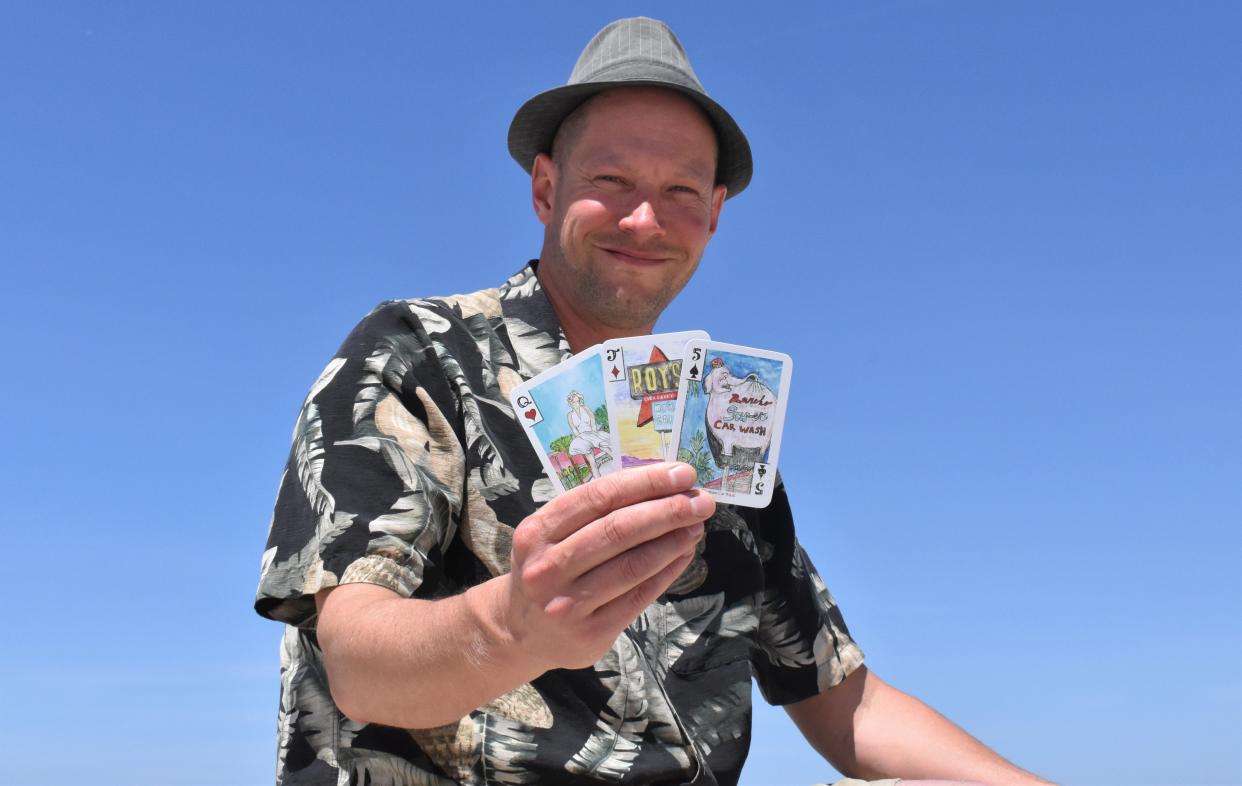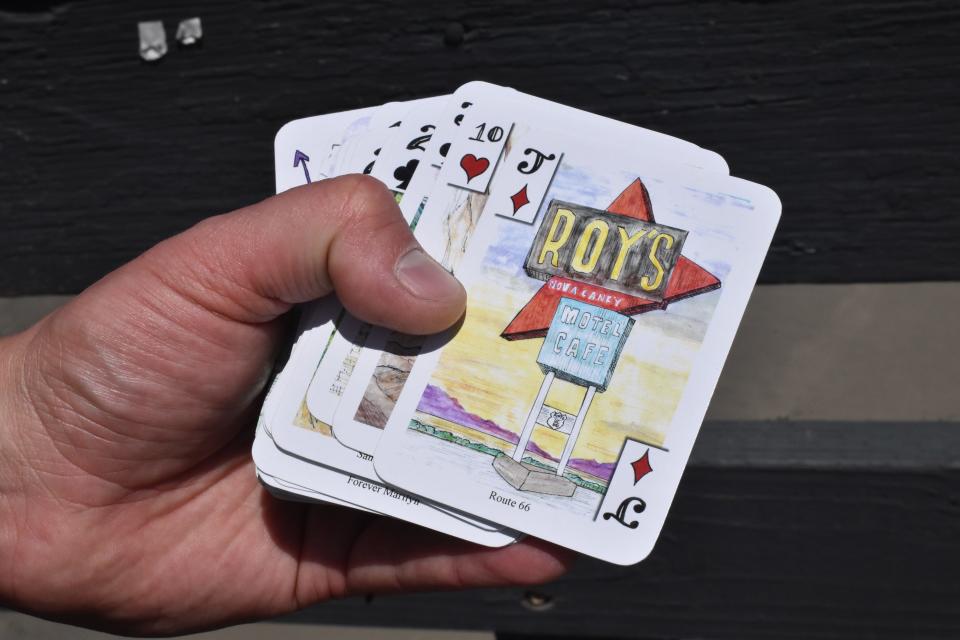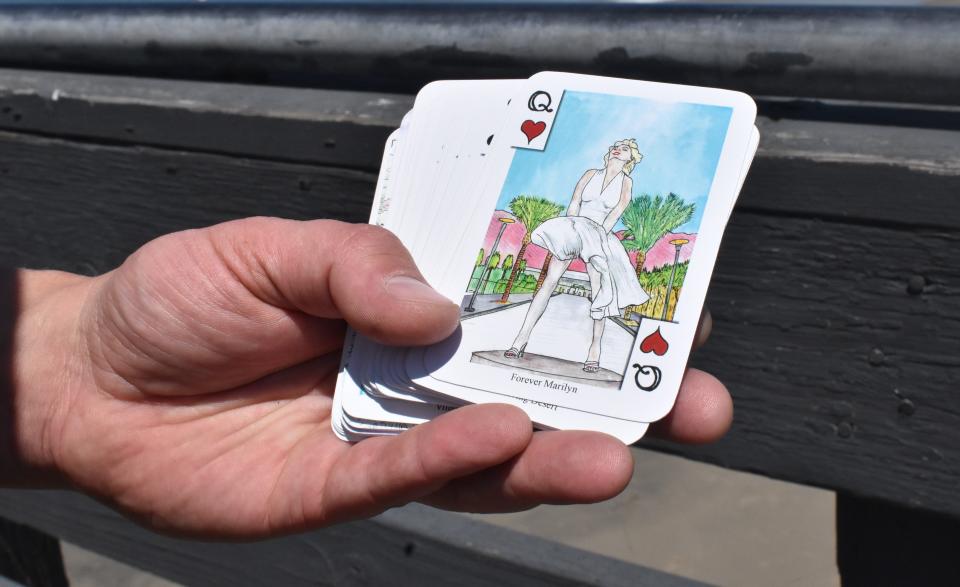How an artist from Oregon found Palm Springs was in the (playing) cards

Aaron Trotter hasn't drawn all the cities of the world. "But that's my plan," he says.
It was February, the time of year when Trotter's home base of Portland, Oregon, is "cold and dark and gloomy," the 44-year-old artist said. "That's when everything's closed up here in Portland. And I usually just spend money in the winter."
So he packed up his black, 2015 Volkswagen Jetta and headed south to California. His destination was Santa Cruz, where he would sell some of his wares — hand-illustrated playing cards of locales from Paris and Rome to Seattle and Mexico City — at a street fair.
"And then I just kept driving," he said. "And because I'm from the Northwest ... I just I was just seeking the sun."
He had heard about Palm Springs' weekly street fair, VillageFest. "I had to check it out. And I saw it, I saw the people there, and I was impressed and I thought, 'Oh, well, I belong here. My booth should be there, right there.' Because I've done lots of street fairs and I'm always up for trying a new one. So I started sketching the city."
He went to the Palm Springs Visitors Center on North Palm Canyon Drive and picked up a map of key local sites. Sketchbook and pen in hand, he started hiking and walking all over the Coachella Valley.
After that week, and a second trip back to the desert in March, he had created dozens of sketches, enough to create a Palm Springs-area card deck — each card illustrated with a scene from the region.
Among the 52 locales: the Wellwood Murray Library downtown, the Palm Springs Art Museum's Architecture and Design Center, the Rancho Mirage Library and Observatory, Cabot's Pueblo Museum in Desert Hot Springs, and 48 more.
On June 23, Trotter will be back at VillageFest, peddling his latest deck, hoping to appeal to desert card sharks and anyone looking for a memento of the Coachella Valley.

Landmarks, new and old
In some ways, art was in Trotter's blood. His father is a sculptor, and his grandmother was a potter and mask-maker who would sell her work at art fairs. "That was the early inspiration for me as a child, seeing my grandma selling her artwork," Trotter says.
After graduating from an arts high school, Trotter attended Evergreen State College in Olympia, Washington, where he studied liberal arts, focusing on 20th-century art and Cubism, plus surrealists and Picasso.
"But I also learned a lot about the Renaissance. And that's one of my big influences — the Renaissance artists. Part of my love for history and travel and printmaking is tied in with playing cards, and the history of playing cards since the Renaissance. All the different kinds of playing cards and tarot cards and collectible cards, and there's just an endless variety of things you can put on playing cards."
The exact origins of playing cards have been lost to history, but Gejus Van Diggele, the chairman of the International Playing-Card Society in London told The Atlantic in 2017 that scholars “generally agree that cards spread from East to West” — perhaps from China.
Playing cards first appeared in Europe in the late 14th century, many scholars say. The first European cards were hand-painted and a luxury for the wealthy. By 1377, cards were causing such disruption that authorities in Paris forbade people from playing cards on workdays, the historian Michael Dummett said in his book "The Game of Tarot."
Trotter's Palm Springs card deck comprises 52 sketches of the desert, composed with pen and then colored with watercolor pencils, largely in pastel hues.
The monochrome jokers, however, are of a different style and subject matter.
"The Joker cards refer to my plan to draw the world, and some of my favorite artists," explains Trotter. "One of the Jokers is [a scene from] Washington D.C., and that's where I kind of had the first how the idea to see the world and draw."
The second Joker is Trotter's version of a work by Albrecht Dürer from the 1500s called "Melencolia."
"That is a very esoteric and complicated scene, but it's supposedly the artist in studio, waiting for inspiration to strike."
In addition to the 52 playing cards plus two jokers, Trotter's deck includes a reference card and map for each suit, explaining the scene on each card and imparting a bit of desert history. Even locals may learn something from these cards.
For example, the reference card for diamonds explains the No. 4 card: "Fountain of Life. Cathedral City fountain made with sculpted stone from Jalisco, Mexico."
Because Trotter's deck was sketched in 2022, it has not only classic landmarks but also recent additions — such as the "Forever Marilyn" sculpture in downtown Palm Springs and the metal dinosaurs in Cathedral City organized by the Museum of Ancient Wonders.
Trotter, who likes to bring his decks to bars and play solitaire, says his cards can be used not only to play games, but to "start a conversation, or inspire a new road or trail to take."

What would it take to make a living at it?
Trotter's first card deck was for Portland. "I originally was just sketching the city landmarks to turn them into all my drawings into postcards, greeting cards, prints and calendars," he recalled. "Eventually, I was selling him some shops and I collected about over 100 drawings of the city. I was just trying everything — what would it take to make a living at it, or pay my rent with it?"
In 2010, he hit upon the idea of playing cards i. He launched what he called a "humble" Kickstarter campaign, seeking $500 to print his first deck.
"I made it at Kinko's. It was all cut and pasted, glued together, and then scanned, and I printed 100 decks, and I folded each box."
From there, the business grew. "Eventually, I found another local printer who was not FedEx Kinkos, who could put a coating on the cardstock and make them feel more like playing cards."
Trotter started ordering 100 decks at a time, then 1,000 at a time, adding new cities as he went. He now has about 50 different decks, and sells a few thousand decks per month, mostly at street fairs like Village Fest.
Trotter sells his cards through a few retailers, but mainly peddles them directly at street fairs like VillageFest and online through his website, www.illustratedplayingcards.com. Decks, which are individually numbered and signed, are $20.
Palm Springs opens a gateway to the Southwest
Trotter says his favorite drawings from the Palm Springs area are the desert scenes. "The hike behind the art museum, the Cactus to Clouds trail, the Lykken Trail. And then I love the canyons, Tahquitz Canyon and Andreas Canyon and all the palm oases," he said.
"I love how you're just sizzling in the heat, hiking through the barren rock landscape. And then suddenly you're in shade. And there's a creek, and it's calm and peaceful and cool."
Trotter says his trip to Palm Springs sparked a desire to draw more of the Southwest.
"I have two sketchbooks worth of drawings from Texas and Arizona. I just went through those trips over the last few months," he said.
Now, he's working on traversing New Mexico. The idea is to create three "state decks" from those places.
"It all started with Palm Springs — I was just so inspired down there," he said. "I just wanted to see more of the desert and see how it all connects. And so I'm I've been drawing the Southwest, and it's really fun."
This article originally appeared on Palm Springs Desert Sun: Oregon artist Aaron Trotter makes Palm Springs playing cards

